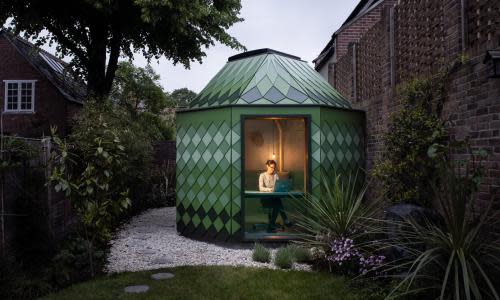Cabin fever: why people are going wild for custom garden rooms

When Virginia Woolf extolled the virtues of having “a room of one’s own” she might have been referring to a cabin in the garden. For anyone who’s had to work from home recently, and is in possession of a patch of outside, a garden getaway where you can labour, undisturbed by cats padding across keyboards or the tug of a toddler’s hand during a conference call, has taken on a new appeal.
But a garden room needn’t just be for work. Thanks to wireless technology and efficient insulation, today’s 21st-century cabins are multi-tasking boltholes. In need of a meditation space, a studio, a guest room or cocktail lounge? The cabin can accommodate every whim.
It can also suit any style. Consider the cabin your grown-up Wendy house where you can – subject to planning – unleash your architectural alter ego. “People really let their personality go wild in garden rooms as they don’t have to live with the result in the house,” says cabin designer Hamish Boden of Studio Hardie. Whimsical follies, mid-century pavilions or bohemian shepherd’s huts can all be bought off the peg or custom-made by specialist firms.
Architects are partial to garden rooms because their compact footprint allows for experimentation with new materials and techniques, on a scaled-down budget. The flat-pack “folly” that architect Ben Allen designed for his brother Jonnie, partner in an engineering firm, and sister-in-law Rachel, a nutritionist, is a case in point. The octagonal room (shortlisted for an Architects’ Journal prize) was inspired by the eccentric Dunmore pineapple pavilion in Scotland, mixed with the form and colour of an artichoke.
“I wanted it to be inexpensive and simple to build,” says Allen, who used digitally pre-cut ply panels, notched and drilled to slot into place, to clad the timber-framed structure that sits at the end of a south London garden. Although the cabin’s size falls within “permitted development” rights, Allen did need planning permission to raise the roof height. With the addition of a skylight, it amplifies the spacious feel of the interior where exposed timbers soar upwards, like rib vaulting in a church. “We use it all year round – as an office, somewhere to read, or for children’s parties,” says Rachel. A bench opens up to become a guest bed. The solid doors open fully in summer. In winter, underfloor heating keeps the room snug. Above the desk, a wide window overlooks the couple’s ground-floor apartment. “During lockdown I sit at my desk in the morning watching Jonnie doing his workout with the children. You always feel connected to what’s going on at home,” she adds.
Potter and photographer Sarah Maingot’s studio has a different feel. Her rustic retreat was built from materials unearthed in the garden of her 18th-century cottage in the Cotswolds. “The previous owners would just throw anything they didn’t want outside. I’m always discovering something: a window, a bit of furniture,” she says. The new space, which Maingot designed with Simon Chadwick of Makers Cabins, replaced a tumble-down outhouse. “It’s evolved organically as we found things,” says Maingot, who makes her “imperfect one-of-a-kind” ceramics here. The Georgian windows were bought on eBay for £100; the oak lintels are offcuts. Inside, wood from the old shed was upcycled as wall cladding, vintage lights painted black for industrial effect and a gallery for storage added. The cabinet was another discovery. “It’s like exploring an archaeological site, full of magical finds,” she says.
Luck also lies behind interior designer Kit Kemp’s getaway. She spotted her shepherd’s hut languishing, unused, in a friend’s garden. “I immediately imagined it at the end of my garden, nestled between silver birches,” says Kemp, founder of the Firmdale hotels group. But first the makeover. Kemp is known for her vivid interiors jostling with art, pattern and handwoven textiles. Her New Forest retreat, with its bohemian interior, has all these things. It also has a thatched roof, which she commissioned from local craftsman John Harman “to add a romantic layer of camouflage”. Inside, walls blaze with folkish motifs painted by decorative artist Melissa White; the sofa bed is scattered with embroidered cushions by Fine Cell, a charity that works with prison inmates. “On sunny mornings I’ll sit on the verandah with a cup of coffee and the dogs join me,” says Kemp. “It’s become my sanctuary.”

